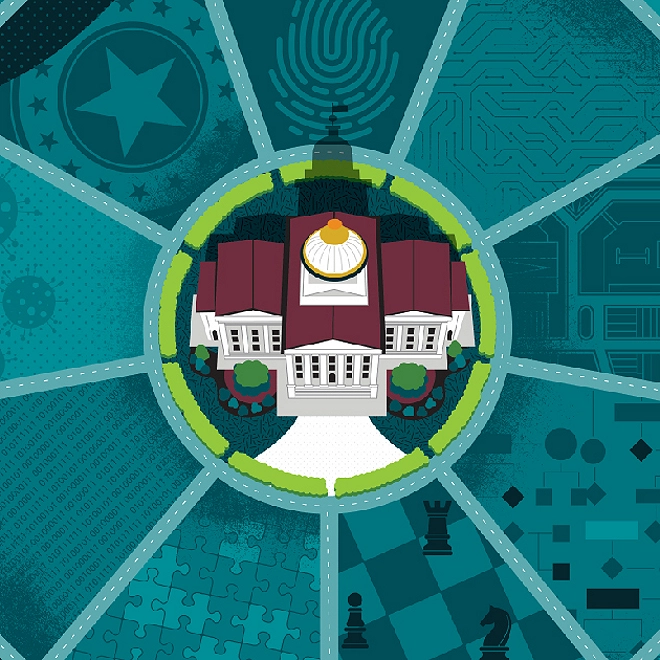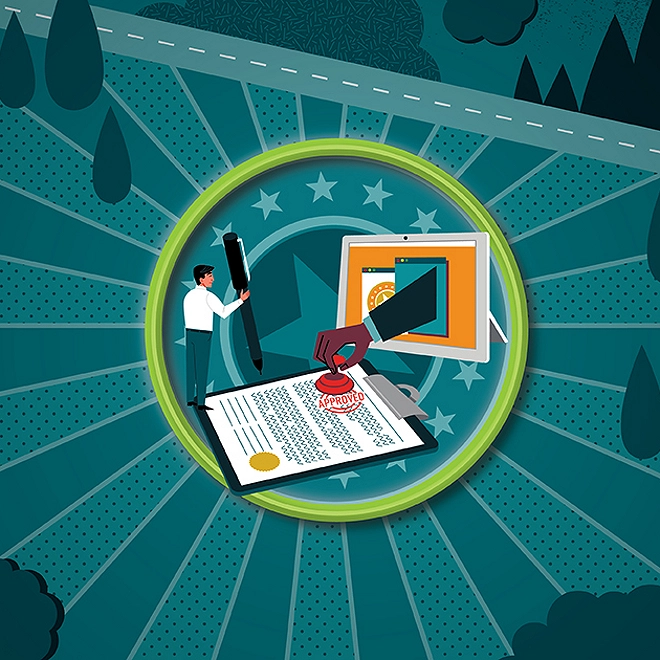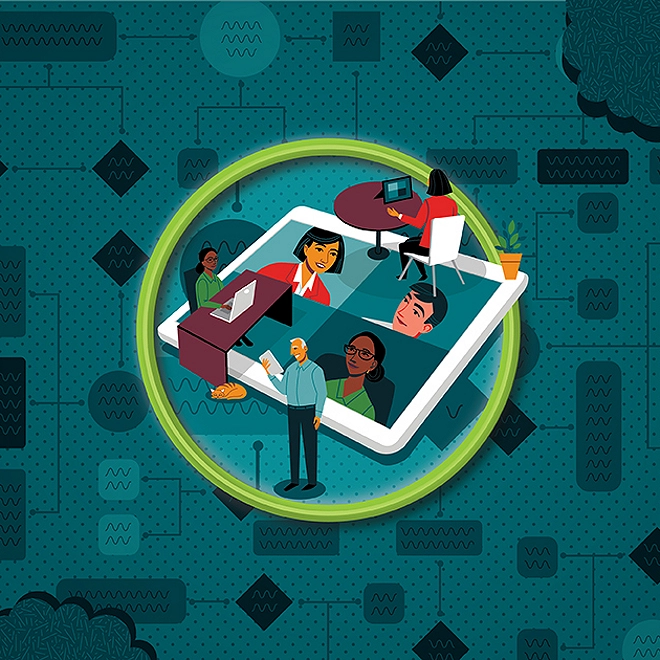Accelerated digital government
COVID-19 brings the next generation of digitisation to government
The COVID-19 pandemic has accelerated—in some cases, by years—the advent of truly digital government.
Prior to the pandemic, governments around the world had been making digital advances, although at an uneven pace. While some had made significant progress, others were still in the early stages of digital transformation. The risk of being “less than perfect” was slowing the transition to digital in many jurisdictions.
When the global pandemic hit, everything changed. Digital was no longer a “nice to have” for government, but an imperative. Consider digital government’s most compelling features: its ability to serve efficiently, scale cheaply and adapt quickly. The disruption of the pandemic made these features more vital than ever.
Globally, the public sector’s response to the pandemic resulted in rapid change of the sort generally not seen in government. From telehealth to telework and virtual courts to virtual education, many large-scale digital innovations were rolled out at unprecedented speed. The digital infrastructure, digital workforce and citizen-facing connectivity that enabled these successes are not just useful during the pandemic; they will lay the foundation for digital government for years to come.
How digitisation has accelerated
To meet the needs of the pandemic, governments accelerated their digital journey along three major dimensions:
1) Scaling digital infrastructure
The pandemic brought about a trifecta of challenges for the governments. As public health officials around the world ordered citizens to stay at home and businesses to operate remotely, government agencies grappled with an explosion in demand for digital services, the need to provide such services in a completely remote environment (at least at the time) and handle requests for new services that never existed before.
As a result, governments around the world have dramatically scaled their digital capabilities. To meet the trifecta of challenges, governments have turned to three complementary digital approaches to tackle each challenge:
i) Ramping up artificial intelligence and automation
As demand soared during the pandemic, governments increasingly turned to automation to keep pace. From automating manual tasks to deploying virtual assistants powered by artificial intelligence (AI), governments used automation tools to provide faster service and reduce human workload. For example, the Romanian Ministry of Labour used robotic process automation (RPA) to distribute direct payments to self-employed workers impacted by COVID-19. Of the 285,000 claims processed, 96% were automated, with each claim taking 36 seconds as opposed to 20 minutes when processed manually.1
In the United States, the Department of Housing and Urban Development, National Institutes of Health and Internal Revenue Service used RPA to help their employees move from low-value to high-value work and to effectively tackle the spike in demand for critical services.2
Similarly, AI-powered virtual assistants, chatbots and “virtual doctors” helped governments provide a quicker COVID-19 response by answering citizen queries, tracing contacts and overcoming language barriers. For instance, France’s AlloCovid service used an AI-based voice assistant to direct citizens with coronavirus symptoms to appropriate health care professionals.3 Meanwhile, Brazil used AI-enabled robots to assist with contact tracing.4
These adoptions are not likely to recede after the pandemic. With 79% of government officials indicating that automation is making a significant positive impact on their business, adoption of automation is likely to continue.5

ii) Harnessing cloud solutions
The pandemic forced governments not only to meet a sudden surge in service demand but to do so remotely. The result was that many governments had to quickly pivot their workforces to remote work and create new channels for virtual service delivery—all at scale, in a matter of weeks. For many, the answer to this challenge lay in harnessing the cloud.
While there are many solutions for remote work, from remote desktops to virtual private networks, many governments that depended on these solutions found them insufficient for coping with the sudden scale of remote work during the pandemic. Cloud, on the other hand, by its very nature, was more quickly scalable, allowing for a seamless transition to telework. In California, for instance, 90% of around 200,000 state employees were able to smoothly switch to telework owing to the state government’s early efforts to pursue cloud.6
The shift to cloud not only allowed employees to work remotely but also helped governments reach citizens. In Singapore, for example, public agencies tapped into “postman.gov.sg,” an omnichannel cloud-based communication tool, to send bulk messages with critical updates to citizens. As of November 2020, the tool had been used to share over 1.3 million messages.7
iii) Building a “whole of government” digital architecture
The pandemic also created demand for completely new services. Most government agencies hadn’t planned to draught social distancing regulations or coordinate vaccine logistics at sub-zero temperatures. While these and other challenges may have been new to many parts of government, they were not necessarily new to government as a whole. Therefore, the key to success was creating a “whole of government” digital architecture that could make relevant solutions created in one area of government available to another.
Although this concept is not new, it has taken on new importance as the pandemic highlighted the need for speedy service delivery and continuity across the public sector.8 By building these efficiencies, governments could increase their public notification capacities, improve security and collaborate across agencies. This is what platforms such as GOV.UK seek to achieve.9 With the help of tools such as GOV.UK Design System, GOV.UK Notify and GOV.UK Pay, both central and local governments have been able to ensure speedy service delivery during the pandemic. For instance, by adding GOV.UK Pay's payment link functionality, the UK Home Office was able to create an online payment portal within weeks to support payments that previously required the staff to be present onsite.10
In another example, the International Telecommunication Union, the United Nations’ specialised agency for information and communication technologies, has collaborated with the governments of Estonia and Germany, as well as with the Digital Impact Alliance, to catalyse digital transformation in low-resource countries. The collaboration plans to build a digital government platform based on secure, reusable and interoperable building blocks that can help low-resource nations deploy and scale their digital services without needing to invest massive resources in building their backend systems.11 Smart Africa, an alliance of 30 African countries that aims to establish Africa as a knowledge economy, is the first implementing partner of the initiative.12
2) Creating a more digital public workforce
Building digital infrastructure is necessary to accelerate the digital drive of the government, but it can’t sustain that momentum by itself. Building a digitally fluent workforce is equally essential. The pandemic highlighted the growing need for a tech-savvy, digitally literate public workforce. As a result, governments are driving efforts to raise the digital literacy of their staff.
For instance, as part of the UK National Data Strategy released in September 2020, the government announced plans to train 500 public sector analysts in data science by 2021.13 Similarly, the US Office of Management and Budget put its data science reskilling pilot to practical use, deploying trainees to analyse data sets from their respective agencies.14 In another instance, Abu Dhabi School of Government and Abu Dhabi Digital Authority collaborated to launch a specialised platform, in December 2020, to improve technology skill levels of the Emirate’s public sector workforce.15
Having skilled public sector workers is such an advantage that it is attracting interest from a wide array of partners. Consider Africa’s Digital Skills for Public Service Employees initiative, developed in collaboration with the World Economic Forum. The initiative helps participating African governments train their workforces in skills critical to recovery efforts, with the added benefit that up to 250 employees get trained free of cost.16 Similarly India’s Mission Karmayogi is a skill development programme that aims to educate civil servants in digital technology, through a subscription-based, public-private model.17 Although driven by the digital demands of the pandemic, the skilled workforces developed in these and other programmes will help serve the public for years to come.
3) Investing in citizen connectivity
Finally, the benefits of ramping up digital solutions and promoting virtualisation of services can be fully realised only when citizens can access such services. Therefore, building public infrastructure that allows better access to digital solutions—especially for the most marginalised populations—becomes necessary.
Several nations have announced initiatives to significantly increase their digital infrastructure spending over the next few years. Investments will go towards improvements such as modernising technology infrastructure, installing fibre networks to increase internet access and closing the “digital divide” between the best- and least-connected communities.
For instance, Spain’s government plans to invest €20 billion in digital infrastructure over the next three years, with an additional €50 billion in private investment as part of its Digital Spain 2025 initiative.18 Meanwhile, the French government intends to spend €7 billion on digital investments, including upgrading public information systems and ramping up digital inclusion efforts for elderly citizens.19
With more citizens using smartphones to access services, improving mobile connectivity is also critical. Take the case of Thailand, where 5G networks are a pivotal component of the government’s Thailand 4.0 digital recovery plan and have helped to drive collaboration between the public and private sectors.20 Similarly, the Scottish Government announced £4 million of funding to build a series of hubs that would deploy 5G services across the country under the Scotland 5G Connect Programme.21 In Australia, the government allocated approximately US$21.2 million to accelerate 5G deployment, including investing in 5G commercial trials and testbeds across key industry sectors.22
Data signals
- According to Gartner forecasts, worldwide government IT investments are shifting from devices and data centres to software and IT services, which together are projected to account for nearly half of the US$452 billion of government IT investments in 2021.23
- In the United States, the Biden administration has proposed adding US$9 billion to the Technology Modernisation Fund for setting up shared IT and cybersecurity services across government.24
- South Korea, recognised as a leader in COVID-19 response, was also ranked the highest in the Organisation for Economic Cooperation and Development’s 2019 Digital Government Index.25
Moving forward
The pandemic has been an inflexion point in the digital maturity of governments. While the initial efforts to accelerate digital transformation have reaped dividends, governments will need to continue the momentum. This means agencies should adopt a cohesive approach to modernising their digital capabilities. Some of the essential components include the following:
- Embracing operational adaptability. Expand the business models that can help the agency adapt and thrive in changing conditions. Rethink the end-to-end organisation structuring and break the silos that affect optimisation.
- Building a flexible and scalable infrastructure. Leverage cloud computing for scalability and agility in administrative processes.
- Creating intelligent workflows. Continue to leverage AI and automation to increase efficiency and migrate human resources to higher-value tasks.
- Enhancing infrastructure resilience. Provide cyber response and resilience to secure infrastructure (network and IT), apps, devices and data at the centre and the edge. Adopt federated security to manage situational awareness and access points as contexts change.
- Developing digitally savvy, open talent networks. Support human-machine collaboration to augment the workforce and provide better service delivery. Additionally, inculcate a digital mindset by training and upskilling the workforce.
- Accelerating with control. Identify areas of digital transformation that need the most acceleration. Alternate between improving citizen experience and operational excellence.
- Continuing the momentum. Use the experience of agility during the pandemic to create the case for continuing the pace of digital transformation.
Enterprise Digital Government Services
Digital transformation in government is quickly becoming an imperative: Customer expectations for digital and mobile experiences are pushing governments to embrace digital transformation as fully as their constituents and commercial enterprises have. Deloitte digital government services can help leaders create a government digital transformation strategy that improves many aspects of public service, including the government customer experience.



